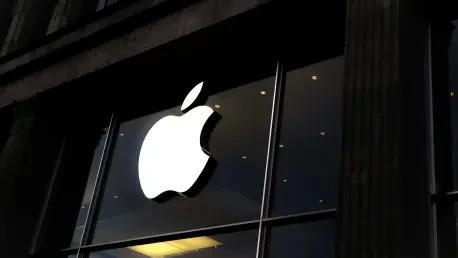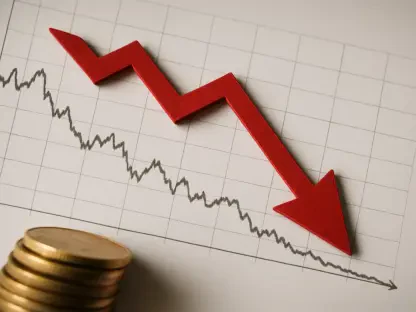In a striking display of market momentum, the U.S. stock indices surged today, with the S&P 500 and Nasdaq Composite taking the lead in a rally that captivated investors across the financial spectrum. This upward movement painted a picture of optimism, as major indices reflected robust gains driven by key players in the technology sector. At the epicenter of this surge was Apple, a company whose stock soared over 5%, acting as a powerful catalyst for the broader market upswing. The day’s performance raises intriguing questions about the forces propelling such significant gains and the specific role Apple played in shaping this financial landscape. Beyond the tech giant’s influence, the market was molded by a complex interplay of corporate earnings, strategic corporate maneuvers, and underlying geopolitical trade tensions that added layers of uncertainty and opportunity. This article delves into the critical factors behind the day’s impressive market performance, unpacking Apple’s pivotal contributions while exploring the broader dynamics at play in the S&P 500 and Nasdaq’s ascent.
Apple’s Monumental Impact on Market Momentum
Today’s market rally bore the unmistakable imprint of Apple (AAPL), as the tech behemoth’s stock climbed nearly 6% following a transformative announcement that reverberated through Wall Street. The company revealed a massive $100 billion investment in U.S. manufacturing, a strategic decision that underscored a shift toward domestic production at a time of heightened global trade friction. This bold move, set to be spotlighted at a White House event alongside CEO Tim Cook and President Trump, not only signaled Apple’s commitment to reducing reliance on foreign supply chains but also positioned it as a leader in navigating complex economic challenges. The announcement served as a powerful boost to investor confidence, directly influencing the stock’s sharp rise and sending a clear message about the company’s long-term vision for stability and growth in the U.S. market.
The ripple effects of Apple’s strategic pivot were felt far beyond its own stock price, as the surge significantly contributed to the Nasdaq Composite’s impressive 1.21% gain, closing at 21,169.42 with an increase of 252.87 points, and the S&P 500’s solid 0.7% uptick. This prior commitment of $500 billion over four years to bolster domestic operations further amplified the impact, painting Apple as a cornerstone of tech sector strength. The company’s ability to align its business strategy with national economic priorities resonated deeply with investors, fueling a broader sense of optimism that lifted other tech stocks in its wake. As a result, Apple’s actions became a linchpin for the day’s market gains, demonstrating how a single corporate decision can sway entire indices and reshape market sentiment in a matter of hours.
Tech Sector Strength Fuels Broader Gains
While Apple led the charge, the broader tech sector emerged as the undeniable engine behind today’s robust market performance across major indices. The Nasdaq’s standout gain of over 1% reflected the sector’s dominance, with tech giants like Amazon, Tesla, and Broadcom each posting gains exceeding 3%, riding the wave of enthusiasm sparked by Apple’s surge. This collective strength highlighted a sustained investor preference for technology-driven companies, particularly in an economic environment where innovation often translates to market leadership. The Dow Jones Industrial Average, by comparison, managed only a modest 0.2% increase, underscoring how tech’s outsized influence overshadowed more traditional sectors on this particular trading day.
Moreover, the tech rally revealed a deeper trend of investor confidence in companies that prioritize cutting-edge advancements and strategic resilience. Apple’s performance acted as a catalyst, reinforcing the notion that technology remains a safe haven for capital amid uncertainties in other industries. This dynamic was evident as market participants gravitated toward firms with strong fundamentals and forward-looking strategies, further solidifying tech’s role as a cornerstone of the S&P 500 and Nasdaq gains. The day’s results suggest that technology will likely continue to drive market momentum, especially as companies like Apple set benchmarks for adaptability and growth that inspire broader sector participation.
Earnings Season Shapes Investor Reactions
The ongoing earnings season provided a critical backdrop to today’s market movements, with Apple’s standout performance contrasting against a landscape of mixed corporate results that tested investor tolerance. While some companies exceeded expectations, others faced sharp declines for even minor shortfalls, illustrating a market with little patience for anything less than stellar outcomes. Apple’s strategic announcements offered a counterbalance to this volatility, providing a narrative of sustained growth that overshadowed the uneven earnings reports from other firms. This context highlighted how pivotal corporate news can stabilize investor sentiment amidst a high-stakes reporting period.
Notably, Shopify emerged as a bright spot with a remarkable 21% stock surge, driven by robust revenue figures and an optimistic forecast that captivated market watchers. In stark contrast, companies like AMD and Snap experienced significant drops, with the latter plummeting 18% due to operational hiccups in its advertising platform. These divergent outcomes underscored the intense scrutiny faced by firms during earnings season, where perfection often seems the only acceptable standard. Apple’s ability to rise above this fray with a focus on long-term investment rather than short-term earnings fluctuations offered a compelling lesson in maintaining market relevance, further cementing its influence on the day’s positive index performance.
Navigating Trade Tensions with Strategic Foresight
Geopolitical trade tensions cast a shadow over the market, with President Trump’s tariff policies introducing uncertainty that affected various sectors and companies differently. Apple, however, demonstrated remarkable agility in navigating these challenges, particularly with its ability to mitigate the impact of new tariffs on imports from India, despite a recent 25% increase tied to the country’s purchase of Russian oil, bringing the total rate to 50%. This strategic foresight, coupled with the focus on U.S. manufacturing, helped cushion a projected $1.1 billion cost headwind for the current quarter, showcasing a proactive approach to policy-induced risks that many firms struggled to match.
By comparison, other corporations faced significant hurdles due to the same trade policies, with companies like Honda reporting a steep profit decline attributed to U.S. auto import tariffs, though an adjusted full-year forecast hinted at adaptive measures. The broader implications of these tariffs were evident in rising oil prices, with West Texas Intermediate and Brent crude climbing over 1% in response to the geopolitical shifts. Apple’s success in sidestepping the worst of these burdens through domestic investment and supply chain adjustments provided a model of resilience, indirectly bolstering investor confidence in tech as a sector capable of weathering global economic storms, and thereby contributing to the S&P 500 and Nasdaq’s upward trajectory.
Shifting Sectoral Priorities in a Dynamic Market
As the tech sector thrived, other industries displayed a patchwork of results that revealed shifting investor priorities in a complex economic environment. Disney, for instance, surpassed earnings expectations thanks to strong streaming and theme park performance, yet its stock dipped slightly due to ongoing declines in linear television, reflecting the challenges of transitioning to digital models. Meanwhile, McDonald’s offered a positive note in the consumer sector, reversing a U.S. sales slump and achieving a 3% stock increase, which suggested pockets of resilience outside technology. These mixed outcomes painted a picture of a market grappling with evolving consumer behaviors and industry-specific headwinds.
Elsewhere, the healthcare sector struggled to maintain investor favor, with Novo Nordisk experiencing a staggering 46% year-to-date decline despite robust sales of its GLP-1 drugs, pointing to a broader pivot toward tech-focused investments over other growth areas. Apple’s alignment with market priorities—emphasizing innovation and strategic domestic investment—positioned it as a leader in this divergent landscape, contrasting sharply with sectors facing skepticism or structural challenges. This divergence underscored why technology, led by Apple, remained the driving force behind today’s gains in the S&P 500 and Nasdaq, as investors sought stability and potential in firms that could adapt to both economic and policy shifts.
Reflecting on a Tech-Driven Market Surge
Looking back on the day’s events, the U.S. stock market witnessed a remarkable rally, with the S&P 500 and Nasdaq posting significant gains fueled by Apple’s extraordinary performance and strategic vision. The tech giant’s stock leap of nearly 6%, spurred by a $100 billion commitment to U.S. manufacturing, not only elevated its own standing but also set a tone of confidence that permeated the tech sector, lifting indices to impressive heights. Amidst a backdrop of varied earnings reports and trade policy uncertainties, Apple’s ability to navigate challenges through proactive investment and supply chain adjustments stood out as a defining factor in the market’s upward movement. Moving forward, market participants might consider monitoring how other companies emulate Apple’s approach to domestic focus and innovation, as well as how trade policies evolve to shape corporate strategies. The day’s dynamics suggest that technology will remain a critical area of focus, offering both opportunities and benchmarks for resilience in an ever-shifting financial landscape.









